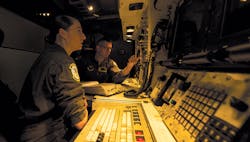Raytheon to build command-and-control SATCOM system to link nuclear forces to national command authorities
HANSCOM AIR FORCE BASE, Mass. – Satellite communications (SATCOM) engineers at Raytheon Technologies Corp. are designing a nuclear command-and-control system to communicate emergency action messages to strategic bomber, tanker, and reconnaissance aircraft crews.
Officials of the Air Force Lifecycle Management Center at Hanscom Air Force Base, Mass., announced a $117.5 million order Friday to the Raytheon Intelligence & Space segment in Marlborough, Mass., to build a Global Aircrew Strategic Network Terminal (ASNT).
The Global ASNT system uses extremely high frequency (EHF) and Advanced EHF waveforms to provide protected communications to nuclear forces such as bomber, missile, and support aircraft crews in difficult environments.
The terminal also will provide wing command posts and mobile support teams with survivable communications to send and receive special alerts involving nuclear forces called Emergency Action Messages.
The Global ASNT terminals that Raytheon is designing will replace existing mission-deficient unsustainable systems at bomber, tanker, and reconnaissance wing command posts and mobile support teams, Air Force officials say.
The Global ASNT terminals will provide advanced EHF, very-low-frequency (VLF), low-frequency (LF), and UHF aircrew alerting communications. Air Force program managers have asked Raytheon to design the Global ASNT SATCOM system with an eye to future growth and systems upgrades.
The new strategic communications system will enhance the existing system by delivering increased capacity and capability, Raytheon officials say.
Raytheon is in production on three different AEHF terminals for the U.S. Army, Navy, and Air Force. All three have tested with the on-orbit AEHF satellite and have demonstrated interoperable communications. The Global ASNT SATCOM system will provide new satellite terminals for the global command-and-control system that helps the U.S. president manage nuclear forces.
Raytheon is designing the new terminals to receive signals from the five satellites in the MILSTAR constellation launched between 1994 and 2003, as well as and the newer AEHF satellite system. Four AEHF satellites are in orbit today, and the Pentagon plans to launch a total of six -- the last two later this year.
The new nuclear command-and-control terminals will be installed at 50 fixed sites including fixed nuclear command-and-control facilities (wing command posts, nuclear task forces, and munitions support squadrons) and forward deployed nuclear command-and-control mobile support teams. The Air Force also plans to buy 48 transportable terminals.
On this contract Raytheon will do the work in Largo, Fla., and should be finished by June 2022. For more information contact Raytheon Space and Airborne Systems online at www.raytheon.com, or the Air Force Lifecycle Management Center at Hanscom Air Force Base at www.wpafb.af.mil/aflcmc.
About the Author
John Keller
Editor-in-Chief
John Keller is the Editor-in-Chief, Military & Aerospace Electronics Magazine--provides extensive coverage and analysis of enabling electronics and optoelectronic technologies in military, space and commercial aviation applications. John has been a member of the Military & Aerospace Electronics staff since 1989 and chief editor since 1995.
